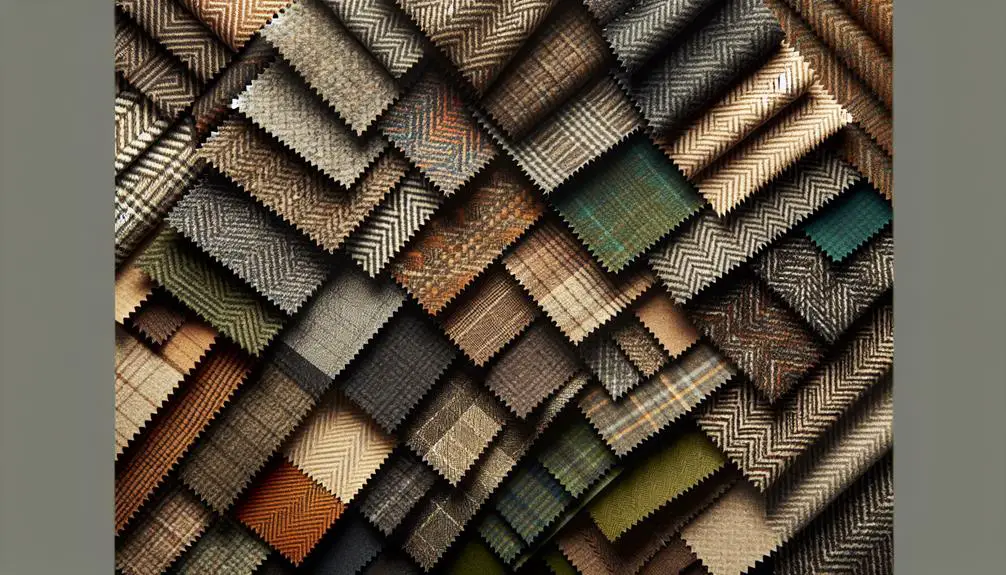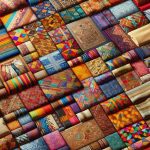I've always been fascinated by the range of colors in tweed, from subtle earth tones to bold, modern shades. This fabric, deeply rooted in Scottish tradition, seems to capture the essence of the landscapes that inspire its hues. It's not just about aesthetics, though; the colors of tweed tell a story of cultural heritage and the natural dyes that bring these fabrics to life. I wonder, how do these traditional methods stand in today's fast-paced fashion world? And what does the future hold for the colors of tweed as trends and technologies evolve? Let's explore this further.
Table of Contents
Key Takeaways
- Tweed traditionally features earthy hues like browns, greens, and grays, reflecting the Scottish landscape.
- Modern tweed colors include vibrant blues, greens, and metallic shades.
- Seasonal tweed colors range, with specific hues chosen for spring, summer, autumn, and winter.
- Patterns in tweed often combine multiple colors, enhancing the fabric's complexity and appeal.
- The color of tweed can be influenced by the dyeing techniques and the natural dyes used, derived from local plants and berries.
The Origins of Tweed Colors
Tweed colors originally originated from the need to blend into the natural landscapes of Scotland. When I explore historical fabric analysis, I discover that each shade and pattern bears deep cultural color significance, reflecting the unique identity and resources of the Scottish regions. For instance, the dyes used were sourced from local plants, moss, and berries, revealing a practical and sustainable approach to textile production.
This method wasn't just about aesthetics; it was a strategic choice. The locals needed attire that would provide camouflage while hunting and tending to daily rural activities. This necessity led to the birth of tweed's varied palette, each adapted to the specific hues of the Scottish highlands, moors, and coastal areas.
Understanding this, I appreciate how tweed is more than just a fabric; it's a narrative woven from the threads of survival, adaptation, and respect for the environment. This insight enriches my mastery of tweed, allowing me to see beyond its texture and patterns to its roots in Scottish tradition and practicality. It's a perfect example of how functionality and culture can shape a material's development and enduring popularity.
Traditional Earthy Hues
When we look at traditional tweed, the colors often reflect the natural world.
The popular palette includes browns, greens, and grays, all sourced from natural dyes.
These hues match the landscapes where tweed originated, grounding it in its environment.
Popular Tweed Color Palette
I've found that the most popular tweed colors typically include rich, earthy hues like greens, browns, and grays. These colors aren't just chosen at random; they're deeply rooted in color psychology, evoking a sense of stability and reliability.
These hues also reflect the traditional weaving techniques used to create tweed. Weavers blend various colored fibers, creating a unique depth that's hard to replicate with other fabrics.
This blend not only enhances the fabric's aesthetic appeal but also its versatility. Whether you're dressing for a formal event or a casual outing, these colors blend seamlessly with other wardrobe elements. Understanding these aspects helps anyone looking to master the art of fashion and textile selection.
Natural Dye Sources
To achieve their traditional earthy hues, tweed fabrics often utilize natural dyes sourced from plants and minerals. I've explored various dye extraction methods to understand how these vibrant yet subdued tones are consistently achieved. Typically, leaves, roots, and bark are simmered to release their natural colors. It's fascinating to see how different materials impact the hue depth.
I also perform color importance tests to make sure these natural dyes hold up well, especially against light and washing. This step is vital because it guarantees the longevity and quality of the tweed's color. Each test gives me insights into which natural sources are most reliable for maintaining their vibrant earthy tones over time.
Modern Tweed Color Trends
As we move into discussing modern trends in tweed, it's evident that color palettes have evolved dramatically.
We're seeing bolder, more vibrant hues making their way into tweed designs. Let's explore what popular color trends are shaping today's tweed and the elements that make them stand out.
Popular Tweed Color Palettes
Modern tweed color trends often feature vibrant palettes, blending classic hues with bold new shades. This mix taps into color psychology, where colors influence our mood and decisions. Urban-inspired shades like deep blues and rich grays are popular, reflecting the sleek aesthetics of city life. These palettes cater to those who want a modern twist on traditional fabrics.
These dynamic combinations aren't just about looking good; they also offer a way to express personality and style. By integrating both timeless and contemporary colors, tweed remains a versatile choice for fashion enthusiasts. As I explore these trends, it's clear that the appeal of tweed lies in its ability to adapt while maintaining its classic charm.
Trending Tweed Design Elements
While exploring the latest trends, I've noticed that contemporary tweed design elements often incorporate unexpected textures and patterns. Modern weaving techniques have allowed designers to experiment more with color and durability, leading to innovative styles. These new methods enhance the fabric's durability without sacrificing its classic appeal.
Today's tweed isn't just about the traditional earth tones; it's about vibrant blues, greens, and even metallics woven into the fabric. This shift not only makes tweed more versatile in fashion but also broadens its use in modern apparel. The interplay of robust weaving techniques and advanced color treatments creates tweed that withstands wear while staying stylish. It's fascinating how a fabric so steeped in tradition can evolve to meet contemporary tastes.
The Role of Dyes in Tweed
Dyes play an essential role in giving tweed its distinctive, varied colors. I've learned that the process of selecting the right dyes and applying them using various dyeing techniques is vital to achieve the vibrant and lasting hues that tweed is known for. One common challenge in this process is ensuring colorfastness. The dyes must hold their color well over time, resisting fading from sunlight and frequent laundering.
To dive deeper into how dyes contribute to tweed's appeal, let's look at a table comparing some common dyes and their characteristics:
| Dye Type | Characteristics |
|---|---|
| Natural Dyes | Eco-friendly, softer hues, less colorfast |
| Synthetic Dyes | Brighter colors, more durable, better colorfastness |
| Acid Dyes | Excellent for wool, vibrant colors |
| Reactive Dyes | Good for cellulose fibers, highly colorfast |
| Vat Dyes | Exceptional light fastness, complex process |
Understanding these options helps me appreciate the craftsmanship behind tweed. Each choice in dye type affects the fabric's final appearance and performance. Whether it's a soft, natural hue or a bright, resilient color, the dyes used in tweed make every piece unique and sought after by those who value both tradition and quality.
Influence of Scottish Landscapes
Exploring further, the majestic Scottish landscapes not only inspire awe but also deeply influence the colors and patterns found in tweed. As I investigate into the heart of Scotland's outdoors, it's clear how directly the natural surroundings shape tweed design.
The Scottish weather impact on tweed is profound. Persistent mists, frequent rains, and sometimes stark sunlight play a role in choosing resilient, muted colors that echo the environment. It's not just about aesthetics; it's about practicality—tweed needs to withstand the elements.
Cultural symbolism in tweed colors also ties back to the land. Each hue can represent a part of Scottish life, whether it's the deep greens of the forested Highlands or the grays mirroring the rocky cliffs.
Here are key ways the landscapes influence tweed:
- Color Inspiration: Earthy tones like mossy greens and peat browns dominate, reflecting the rugged terrain.
- Durability Needs: Given the harsh weather, tweeds are crafted to be as enduring as the landscapes they come from.
- Cultural Ties: Specific colors often have historical significance, connecting wearers with their heritage.
- Seasonal Shifts: Color palettes change with the seasons, much like the Scottish scenery itself, from lush summer greens to stark winter grays.
This deep connection ensures that wearing tweed is basically carrying a piece of Scotland with you.
Patterns and Color Combinations
I often marvel at how the intricate patterns and bold color combinations in tweed reflect the diversity of the Scottish landscape. Tweed's aesthetic isn't just about style; it's steeped in color psychology, influencing both the weaver's choice and the wearer's feelings. Different hues and patterns can evoke calmness, energy, or sophistication, subtly shaping how we feel and interact.
The weaving techniques used in tweed production also play an important role. These methods allow for a blend of varied colored threads, creating complex patterns like herringbone, check, or plaid. Each pattern isn't just a visual treat but a tribute to the weaver's skill and the rich weaving heritage of Scotland.
Understanding these elements helps me appreciate tweed beyond its surface. It's about a narrative woven into every thread. When I choose a tweed garment, I'm not just selecting based on color or pattern. I consider the craftsmanship behind it, the story it tells, and how it might subtly influence my mood and presence. Therefore, tweed becomes more than fabric; it's a dynamic canvas of art and emotion, draped in history and culture.
Seasonal Color Variations
Tweed colors shift with the seasons, mirroring the changing landscapes they originate from. As someone deeply fascinated by how nature influences textile design, I've noted how these variations aren't just aesthetic but practical, adapting to both the climate influence and the cultural ambiance of different times of the year.
Here's how tweed colors adapt seasonally:
- Spring: Lighter, softer hues like sky blue and pale green emerge, reflecting the fresh, blooming flora.
- Summer: Vibrant shades such as sunlit yellow and ocean blue prevail, echoing the vividness of the season.
- Autumn: Rich, warm tones like amber, rust, and deep green set in, inspired by the falling leaves and the earthy environment.
- Winter: Darker, more subdued colors dominate, like charcoal and navy, complemented occasionally by bright, festive holiday hues that add a pop of color against the stark winter landscapes.
This dynamic palette guarantees that tweed remains both functional and stylish throughout the year, offering warmth or breathability as needed while celebrating seasonal beauty. The careful selection of colors according to season emphasizes tweed's deep connection to its origins and its ability to stay relevant in the ever-evolving world of fashion.
Tweed in Fashion Design
As we look at tweed in fashion design, it's clear that this fabric has some iconic styles that have stood the test of time.
We'll also explore how modern designers are innovating with tweed in exciting new ways.
It's fascinating to see how a traditional material is being reinterpreted in today's fashion world.
Iconic Tweed Styles
Often, designers incorporate tweed into their collections to add a touch of timeless elegance. The fabric's rich texture and durability make it a favorite, not just for its aesthetic appeal but also because it's important. I've noticed that understanding tweed fabric care is essential for maintaining its charm. Celebrities often choose tweed for its classic look, influencing trends greatly.
Here are some iconic tweed styles:
- Chanel's Classic Tweed Jacket: Revolutionized women's fashion with its sophisticated edge.
- Harris Tweed Blazers: Known for their authenticity and quality.
- Tweed Trousers: Popular for both their style and comfort.
- Tweed Accessories: Caps and bags that add a rustic, yet chic flair to any outfit.
Modern Tweed Innovations
Designers are constantly innovating with tweed, using it in unexpected ways to refresh traditional fashion norms. They're incorporating cutting-edge tweed recycling methods that not only reduce waste but also introduce a sustainable edge to high fashion. These methods allow old tweed garments to be transformed into fresh, stylish pieces without compromising the classic texture that makes tweed unique.
Moreover, the advent of digital tweed textures is revolutionizing how this material is used in design. By digitally manipulating tweed patterns, designers can create intricate, customizable fabrics that maintain the authenticity of traditional tweed while pushing the boundaries of modern aesthetics. This fusion of old and new ensures that tweed remains a staple in the ever-evolving fashion landscape.
Choosing Colors for Tweed
When selecting colors for tweed, consider the setting and purpose of your outfit. Tweed is versatile, but its colors can deeply influence how it's perceived. Let's explore how you can choose the best colors for your tweed garments while understanding the impact of color symbolism and texture influence.
- Seasonal Sensibility: Opt for lighter shades like pastels in spring and summer, and shift to earth tones in autumn and winter. This seasonal approach not only aligns with the weather but also complements the natural landscape.
- Formal or Casual: Dark, solid colors like navy or charcoal convey formality and are perfect for business settings. Conversely, brighter colors or mixed patterns are more casual and great for social outings.
- Personal Style: Select colors that reflect your personality. If you're adventurous, bold patterns in vibrant colors can showcase your flair. If you prefer a subtle elegance, muted tones like gray or olive might be your go-to.
- Texture Play: Tweed's texture can affect how its color looks. A rough texture can make a color appear more muted, while a smoother weave might bring out the brightness.
The Future of Tweed Colors
Looking ahead, the evolution of tweed colors seems set to embrace both innovative and sustainable dyeing techniques. As we explore the future, I see the potential for groundbreaking shifts in how we approach this traditional fabric. The integration of synthetic dyes is a key component. These dyes offer vibrant, long-lasting colors that can transform the classic tweed palette. Yet, they must be used responsibly to minimize environmental impact.
The rise of color technology advancements plays an essential role. Techniques like digital dyeing and eco-friendly chemical formulations are stepping up. They promise to reduce water usage and pollution, vital in making tweed production more sustainable. I'm particularly excited about these developments. They not only aim to preserve our planet but also expand the artistic possibilities of tweed.
Moreover, the trend towards customizing and personalizing tweed items could further drive innovation in coloration. Imagine tweeds in dynamic, unconventional colors tailored to individual preferences, all achieved without harming the environment. It's a thrilling prospect that combines tradition with cutting-edge technology.
Frequently Asked Questions
How Do I Remove Stains From Tweed Fabric?
To remove stains from tweed, I start with gentle tweed cleaning products and blot the area. If that doesn't work, I'll turn to professional stain removal services to guarantee no damage occurs.
Is Tweed Suitable for Summer Wear?
I wouldn't advise tweed for summer wear due to its low breathability. It's better suited for cooler weather, so you might want to explore lighter fabrics for your summer styling needs.
What Accessories Pair Well With Tweed?
I've found that leather boots and wool hats complement tweed textures beautifully, enhancing its seasonal versatility. A silk scarf or structured bag can also elevate the outfit, making the ensemble more sophisticated.
Can Tweed Be Used for Formal Events?
Absolutely, tweed can be perfect for formal events. Its rich textures elevate any look, ensuring event appropriateness. I've worn tweed suits to weddings and galas, always receiving compliments on my sophisticated choice.
How Should Tweed Garments Be Stored?
I store my tweed garments in breathable garment bags to prevent moth damage. For seasonal storage, I use cedar blocks for extra protection. These tweed care tips guarantee my clothes stay in perfect condition.
- How Does Ring Spun Cotton Affect Garment Fit and Shape Retention? - August 13, 2024
- What Are the Challenges in Producing Ring Spun Cotton? - August 13, 2024
- Is Ring Spun Cotton Suitable for Plus-Size Clothing? - August 13, 2024







